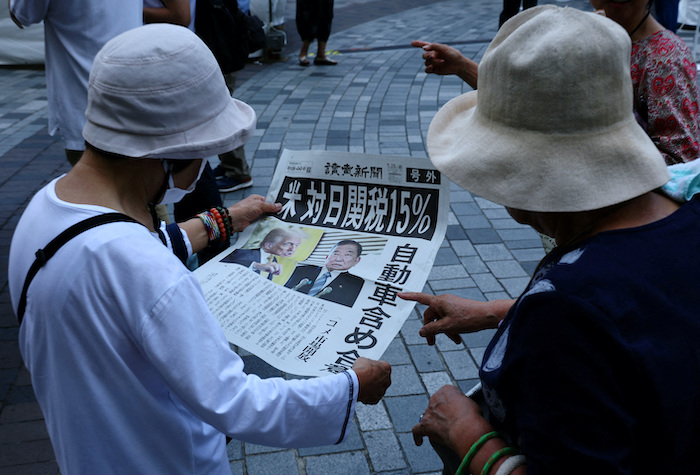Auto stocks surged in Tokyo on Wednesday after US President Donald Trump struck a trade deal with Japan that lowers tariffs on imported cars to 15%.
The agreement helps Japan avoid punishing new levies on other goods in exchange for a $550-billion package of US-bound investment and loans.
It is the most significant of a clutch of agreements that Trump has bagged since unveiling sweeping global levies in April, though like other deals, exact details remained unclear.
ALSO SEE: Is China Finally Set to Rein in its Huge Industrial Overcapacity?
Japan’s auto sector, which accounts for more than a quarter of its US exports, will see existing tariffs cut to 15% from levies totaling 27.5% previously.
Duties that were due to come into effect on other Japanese goods from August 1 will also be cut to 15% from 25%.
The announcement sent Japan’s benchmark Nikkei stock index climbing almost 4% to its highest in a year, led by stocks in automakers with Toyota up more than 14% and Honda nearly 11%.
“I just signed the largest TRADE DEAL in history with Japan,” Trump said on his Truth Social platform. “This is a very exciting time for the United States of America, and especially for the fact that we will continue to always have a great relationship with the Country of Japan,” he added.
Japanese Prime Minister Shigeru Ishiba, who denied reports on Wednesday that he had decided to quit following a bruising Upper House election defeat, hailed the tariff agreement as “the lowest rate ever applied among countries that have a trade surplus with the US.”
Two-way trade between the two countries reached nearly $230 billion in 2024, with Japan running a trade surplus of nearly $70 billion. Japan is the fifth-largest US trading partner in goods, data from the US Census Bureau shows.
$550 billion package of investment in US
The US investment package includes loans and guarantees from Japanese government-affiliated institutions of up to $550 billion to enable Japanese firms “to build resilient supply chains in key sectors like pharmaceuticals and semiconductors,” Ishiba said.
Japan will also increase purchases of agricultural products such as US rice, a Trump administration official said. Ishiba said the share of US rice imports may increase under its existing framework but that the agreement did “not sacrifice” Japanese agriculture.
Bank of Japan Deputy Governor Shinichi Uchida called the deal “very big progress” and said it reduces uncertainty over the economic outlook.
Some economists had forecast the tariffs could have tipped Japan – the world’s fourth-largest economy – into recession.
Keidanren, Japan’s biggest business lobby, welcomed the deal, saying it was a recognition of the significant contributions Japanese companies have made to the US economy and society.
The exuberance in financial markets spread to shares of South Korean and European carmakers, as the Japan deal stoked optimism that they could strike similar deals.
US carmakers not happy
But US automakers signalled their unhappiness with the deal, raising concerns about a trade regime that cuts tariffs on Japanese auto imports while leaving tariffs on imports from their plants and suppliers in Canada and Mexico at 25%.
“Any deal that charges a lower tariff for Japanese imports with virtually no US content than the tariff imposed on North American-built vehicles with high US content is a bad deal for US industry and US auto workers,” said Matt Blunt, who heads the American Automotive Policy Council, which represents General Motors, Ford and Chrysler parent Stellantis.
After his meeting with Trump at the White House on Tuesday, Japan’s top trade negotiator Ryosei Akazawa wrote on X: “#Mission Complete.”
Akazawa later said the deal does not cover Japanese exports of steel and aluminum, currently subject to a 50% tariff.
As part of the agreement, Japan will drop additional safety tests currently imposed on imported US cars and trucks, Akazawa added, requirements that Trump has said limit sales of American-made autos there.
Some last-minute negotiations over the eye-catching investment package appear to have helped seal the deal, a photo of Akazawa’s meeting with Trump posted by one of his aides showed.
A photo posted on X by Trump’s assistant Dan Scavino showed the president seated opposite Akazawa with a document titled ‘Japan Invest America’ in front of him. A sum of “$400B” written in large letters on the document was scored out, with “$500” handwritten above it.
Japan is the largest foreign investor in the United States, according to US government data, with an investment position of $819 billion at the end of 2024.
Hope for JV on Alaska pipeline
Speaking later at the White House, Trump also expressed fresh optimism that Japan would form a joint venture with Washington to support a gas pipeline in Alaska long sought by his administration.
Trump aides are feverishly working to close trade deals ahead of an August 1 deadline that Trump has repeatedly pushed back under pressure from markets and intense lobbying by industry.
By that date, countries are set to face steep new tariffs beyond those Trump has already imposed since taking office in January.
Trump has announced framework agreements with Britain, Vietnam, Indonesia and paused a tit-for-tat tariff battle with China, though details are still to be worked out with all of those countries.
At the White House, Trump said negotiators from the European Union would be in Washington on Wednesday.
Reuters with additional editing by Jim Pollard
ALSO SEE:
Japanese PM Ishiba Vows to Kick on Despite Loss of Upper House
Japan, South Korea Desperate to Reduce 25% Tariff by August
Japan’s PM Defends National Interest as Trump Ramps up Threats
Japan Says It’s In No Rush For A Trade Deal With The US
White House Invites Asian Allies to See Alaska LNG Project
Japan May do Pipeline, Energy Deals to Appease Trump
Yen Rises After Bank of Japan Lifts Rates to Highest Since 2008
SoftBank, UAE’s MGX Join $500bn Data Centre Deal With OpenAI

